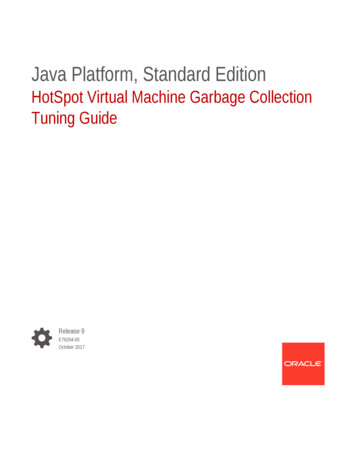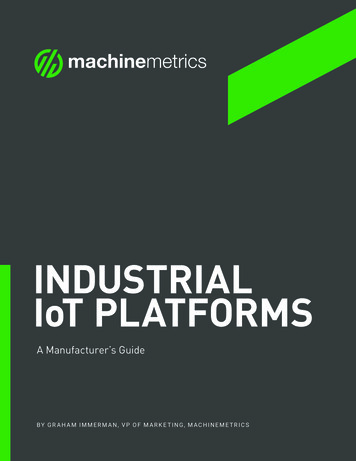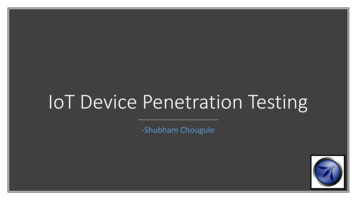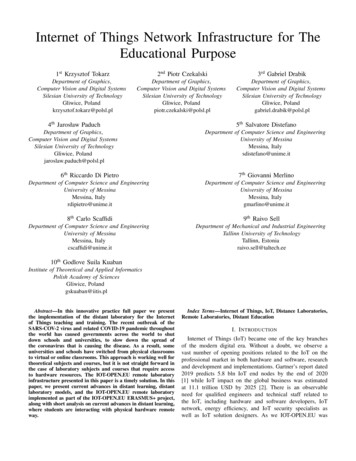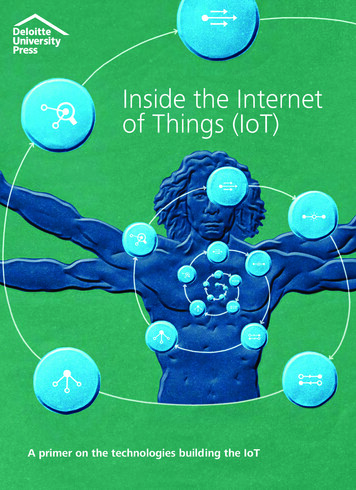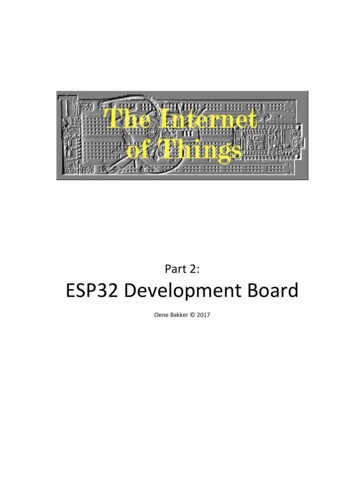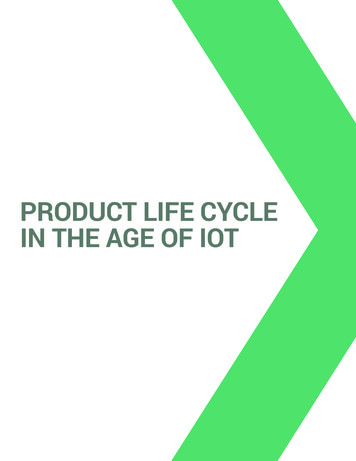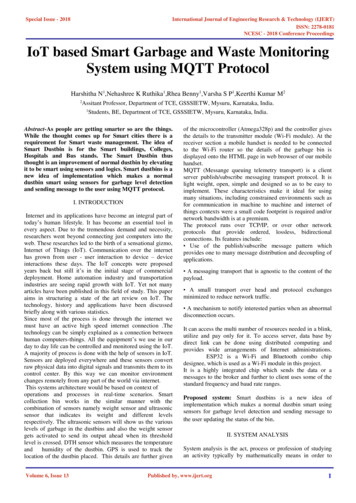
Transcription
Special Issue - 2018International Journal of Engineering Research & Technology (IJERT)ISSN: 2278-0181NCESC - 2018 Conference ProceedingsIoT based Smart Garbage and Waste MonitoringSystem using MQTT ProtocolHarshitha N1,Nehashree K Ruthika1,Rhea Benny1,Varsha S P1,Keerthi Kumar M22Assitant Professor, Department of TCE, GSSSIETW, Mysuru, Karnataka, India.1Students, BE, Department of TCE, GSSSIETW, Mysuru, Karnataka, India.Abstract-As people are getting smarter so are the things.While the thought comes up for Smart cities there is arequirement for Smart waste management. The idea ofSmart Dustbin is for the Smart buildings, Colleges,Hospitals and Bus stands. The Smart Dustbin thusthought is an improvement of normal dustbin by elevatingit to be smart using sensors and logics. Smart dustbins is anew idea of implementation which makes a normaldustbin smart using sensors for garbage level detectionand sending message to the user using MQTT protocol.I. INTRODUCTIONInternet and its applications have become an integral part oftoday’s human lifestyle. It has become an essential tool inevery aspect. Due to the tremendous demand and necessity,researchers went beyond connecting just computers into theweb. These researches led to the birth of a sensational gizmo,Internet of Things (IoT). Communication over the internethas grown from user - user interaction to device – deviceinteractions these days. The IoT concepts were proposedyears back but still it’s in the initial stage of commercialdeployment. Home automation industry and transportationindustries are seeing rapid growth with IoT. Yet not manyarticles have been published in this field of study. This paperaims in structuring a state of the art review on IoT. Thetechnology, history and applications have been discussedbriefly along with various statistics.Since most of the process is done through the internet wemust have an active high speed internet connection .Thetechnology can be simply explained as a connection betweenhuman computers-things. All the equipment’s we use in ourday to day life can be controlled and monitored using the IoT.A majority of process is done with the help of sensors in IoT.Sensors are deployed everywhere and these sensors convertraw physical data into digital signals and transmits them to itscontrol center. By this way we can monitor environmentchanges remotely from any part of the world via internet.This systems architecture would be based on context ofoperations and processes in real-time scenarios. Smartcollection bin works in the similar manner with thecombination of sensors namely weight sensor and ultrasonicsensor that indicates its weight and different levelsrespectively. The ultrasonic sensors will show us the variouslevels of garbage in the dustbins and also the weight sensorgets activated to send its output ahead when its thresholdlevel is crossed. DTH sensor which measures the temperatureandhumidity of the dustbin. GPS is used to track thelocation of the dustbin placed. This details are further givenVolume 6, Issue 13of the microcontroller (Atmega328p) and the controller givesthe details to the transmitter module (Wi-Fi module). At thereceiver section a mobile handset is needed to be connectedto the Wi-Fi router so the details of the garbage bin isdisplayed onto the HTML page in web browser of our mobilehandset.MQTT (Messange queuing telemetry transport) is a clientserver publish/subscribe messaging transport protocol. It islight weight, open, simple and designed so as to be easy toimplement. These characteristics make it ideal for usingmany situations, including constrained environments such asfor communication in machine to machine and internet ofthings contexts were a small code footprint is required and/ornetwork bandwidth is at a premium.The protocol runs over TCP/IP, or over other networkprotocols that provide ordered, lossless, bidirectionalconnections. Its features include: Use of the publish/subscribe message pattern whichprovides one to many message distribution and decoupling ofapplications. A messaging transport that is agnostic to the content of thepayload. A small transport over head and protocol exchangesminimized to reduce network traffic. A mechanism to notify interested parties when an abnormaldisconnection occurs.It can access the multi number of resources needed in a blink,utilize and pay only for it. To access server, data base bydirect link can be done using distributed computing andprovides wide arrangements of Internet administrations.ESP32 is a Wi-Fi and Bluetooth combo chipdesignee, which is used as a Wi-Fi module in this project.It is a highly integrated chip which sends the data or amessages to the broker and further to client uses some of thestandard frequency and baud rate ranges.Proposed system: Smart dustbins is a new idea ofimplementation which makes a normal dustbin smart usingsensors for garbage level detection and sending message tothe user updating the status of the bin.II. SYSTEM ANALYSISSystem analysis is the act, process or profession of studyingan activity typically by mathematically means in order toPublished by, www.ijert.org1
Special Issue - 2018International Journal of Engineering Research & Technology (IJERT)ISSN: 2278-0181NCESC - 2018 Conference Proceedingsdefine its goals or purposes and to discover operation andprocedures for accomplishing them most efficiently.III. HARDWARE REQUIREMENTSThe hardware requirements for the system are as follows.3.1 Ultrasonic Sensors: Knowing the distance you are awayfrom an object is very important in robotics or even for tasksjust as simple as driving.Fig 2: Arduino boardTable 1, briefs the summary of this microcontroller boardMicrocontrollerOperating VoltageInput Voltage (recommended)Input voltage (limit)Digital I/O pinsFig1: Ultrasonic sensorAs shown in the Fig 1. Ultrasonic distance sensors use asound transmitter and a receiver. An ultrasonic distancesensor creates an ultrasonic pulse, often called a "ping", andthen listens for reflections (echo) of the pulse. This pulse ofsound is generally created electronically using aSonar projector consisting of a signal generator, poweramplifier and electro-acoustic transducer/array.A beam former is usually employed to concentrate theacoustic power into a beam.To measure the distance to an object, the time fromtransmission of a pulse to reception is measured andconverted into a range by knowing the speed of sound. Thissignal together with noise is then passed through variousforms of signal processing, which for simple sensors may bejust energy measurement. It is then presented to some form ofdecision device that calls the output either the required signalor noise. This decision device may be an operator withheadphones or a display, or in some systems this functionmay be carried out by software.Further processes may be carried out to classify the target andlocalize it, as well as measuring its velocity. Some ultrasonicsensors have multiple beams to provide all round cover whileothers only cover a narrow arc, although the beam may berotated, relatively slowly, by mechanical scanning.3.2 Arduino Board:As shown in Fig 2, the Mega 2560 is a microcontroller boardbased on the ATmega2560. It has 54 digital input/ output pins(of which 15 can be used as PWM outputs), 16 analog inputs,4UARTs (hardware serial ports), a 16 MHz crystal oscillator,a USB connection, a power jack, an ICSP header, and a resetbutton. It contains everything needed to support themicrocontroller; simply connect it to a computer with a USBcable or power it with an AC-to-DC adapter or battery to getstarted. The Mega 2560 board is compatible with mostshields designed for the Uno and the former boardsDuemilanove Or diecimila.Volume 6, Issue 13Analog InputsATmega25605V7-12V6-20V54 (of which 15 provide PWMoutput)16Table 2, Features of Arduino boardPinsDC Current per I/O PinDC Current for 3.3V PinFlash MemorySRAMEEPROMClock speedLengthWidthWeight20mA50mA256KB of which 8KB used by bootloader8 KB4 KB16 MHz101.52 mm53.3 mm37 g3.3 WI-FI MODULE ESP32ESP32 is a single2.4GHz Wi-Fi and Bluetooth combo chipdesigned with TMSC ultra-low-power 40nm technology.Fig3: Wi-Fi module (ESP32)It is designed to achieve the best power and RF performance,showing robustness, versatility and reliability in a widevariety of application and different power profile. ESP32 isdesigned for mobile, wearable electronics, and Internet-ofThings (IoT) applications as shown in the figure3. It featuresall the state-of-the-art characteristics of low-power chips,Published by, www.ijert.org2
Special Issue - 2018International Journal of Engineering Research & Technology (IJERT)ISSN: 2278-0181NCESC - 2018 Conference Proceedingsincluding fine-grained clock gating, multiple power modes,and dynamic power scaling. For instance, in a low-power IoTsensor hub application scenario, ESP32 is woken upperiodically and only when a specified condition is detected.Low duty cycle is used to minimize the amount of energy thatthe chip expends. The output of the power amplifier is alsoadjustable, thus contributing to an optimal trade-off betweencommunication range, data rate and power consumption.on what you want to build, an LCD is a highly useful outputdevice for your Arduino.3.6 GPS RECIEVER MODULEThe GP-20U7 is a compact GPS receiver with a built-in highperformances all-in-one GPS chipset. The GP-20U7accurately provides position, velocity, and time readings aswell possessing high sensitivity and tracking capabilities.Thanks to the low power consumption this receiving GP20U7 is deal for portable applications such as tablet PCs,smart phones, and other devices requiring positioningcapability.Fig5: GPS receiver3.7 Cloud StorageFig.4:System Architecture3.4 WEIGHT SENSOR MODULEA weight sensor is a load cell used as a force sensing module.It is a metal structure, with small elements called straingauges mounted in precise location on the structure. Load cellare IoT based smart garbage and waste management usingMQTT protocol designed to measure a specific force, andignores and other force being applied. The electric signaloutput by the load cell is very small and requires specializedamplification. Fortunately, the 1046 Phidget Bridge willperform all the amplification and measurement of theelectrical output. Load cell are designed to measure in onedirection. They will often measure force in other directions,but sensor sensitivity will be different, since part of the loadcell are operating under compression are now in tension, andvice versa.Cloud computing is the practice of using remote servers onthe internet to manage, store and process data instead of usinga personal computer.Cloud computing is a general term that is better divided intothree categories: Infrastructure-as-a- Service, Platform-as-aService, and Software-as-a- Service. IaaS (or utilitycomputing) follows a traditional utilities model, providingservers and storage on demand with the consumer payingaccordingly. PasS allows for the construction of applicationswithin a provider’s framework, like Google’s App Engine.SaaS enables customers to use an application on demand viaa browser. A common example of cloud computing is Gmail,where you can access your stored data from any computerwith internet access. M2M (Machine to Machine) devices,comprises that are directly connected to the cellular network,such as cars that can report their location (in case of anaccident or theft), or vending machines that can call in whentheir stocks are running low.3.5 LCD DISPLAYIV. SOFTWARE REQUIREMENTSInterfacing a character LCD to an Arduino UNO adds a niceelement of readability to your project. Many of the bestArduino projects around the world sport LCD displays. TheseLCDs can be used to display information from the Arduino orany sensor connected to it. For example, you can create atemperature monitoring system which displays thetemperature on your Arduino. You can make your ownspeedometer that displays your speed on the LCD. DependingVolume 6, Issue 131. Arduino IDE2. Arduino Language3. Blynk app4.1 Arduino IDE:The Arduino Integrated Development Environment - orArduino Software (IDE) - contains a text editor for writingPublished by, www.ijert.org3
Special Issue - 2018International Journal of Engineering Research & Technology (IJERT)ISSN: 2278-0181NCESC - 2018 Conference Proceedingscode, a message area, a text console, a toolbar with buttonsfor common functions and a series of menus as shown in figIt connects to the Arduino and Genuine hardware to uploadprograms and communicate with them.V. IMPLEMENTATION AND WORKING5.1 Flow chartFig6: Arduino IDEWriting Sketches: Programs written usingArduino Software (IDE) are called sketches.These sketches are written in the text editor and are savedwith the file extension in. The editor has features forcutting/pasting and for searching/replacing text. The messagearea gives feedback while saving and exporting and alsodisplays errors. The console displays text output by theArduino Software (IDE), including complete error messagesand other information. The bottom right hand corner of thewindow displays the configured board and serial port. Thetoolbar buttons allow you to verify and upload programs,create, open, and save sketches, and open the serial monitor.4.2 Arduino Language:Arduino Language is used for programming in Arduino IDE.The Arduino language is merely a set of C/C functions thatcan be called from your code. Your sketch undergoes minorchanges (e.g. automatic generation of function prototypes)and then is passed directly to a C/C compiler (aver-g ).4.3 Blynk appBlynk was designed for the Internet of Things. It can controlhardware remotely, it can display sensor data, it can storedata, vizualize it and do many other cool things.Volume 6, Issue 13Fig7: flow chart5.2 WorkingModule 1: 5 Volt power supply is enough to power up the circuit. All the sensors will act as a transducer. GPS location value is calculated. Physical data are collected by Arduino and send toESP32 Wi-Fi module as digital data.Module 2: ESP32 will send the data to the client server. IP adders of the client is pre defined in the programusing that readings of sensor values are sent. Client will receive all the data from the host, displayedon dash board of Blynk app.VI. RESULTS AND CONCLUSION:Here the result obtained is, Text message sent to the server toclient using IOT and it’s also displayed on the LCD display.Successfully reduce risks of non-compliance by trackingregulations applicable to every waste profile.Fastly and easily generate RCRA hazardous waste report in auser friendly way.Published by, www.ijert.org4
Special Issue - 2018International Journal of Engineering Research & Technology (IJERT)ISSN: 2278-0181NCESC - 2018 Conference ProceedingsREFERENCESP.Suresh1J. Vijay Daniel2, Dr.V.Parthasarathy4” A state of the artreview on the Internet of Things (Iota)” International Conferenceon Science, Engineering and Management Research (ICSEMR2014)[2] ArkadyZaslavsky, DimitriosGeorgakopoulos” Internet of Things:Challenges and State-of-the-art solutions in Internet-scale SensorInformation Management and Mobile Analytics” 2015 16th IEEEInternational Conference on Mobile Data Management[3] Theodoros.Anagnostopoulos1,Arkady.Zaslavsky,1, AlexeyMedvedev1, Sergei Khoruzhnicov1” Top–k Query based DynamicScheduling for IoTenabled Smart City Waste Collection” 201516th IEEE International Conference on Mobile Data Management[4] Manoj and Kannan E.P, “Data Acquaisition and Basic Feature,“Solid waste Management Project by MCGM.[5] “City Garbage collection indicator using RF (Zigbee) and GSMtechnology”[6] Vikrant Bhor, PankajMorajkar, MaheshwarGurav, DishantPandya4 “Smart Garbage Management System” InternationalJournal of Engineering Research & Technology (IJERT) ISSN:2278-0181 IJERTV4IS031175 Vol. 4 Issue 03, March-2015.[7] Insung Hong, Sunghoi Park, Beomseok Lee, Jaekeun Lee,DaebeomJeong, and Sehyun Park, “IoT-Based Smart GarbageSystem for Efficient Food Waste Management”. The ScientificWorld Journal Volume 2014 (2014), Article ID 646953.[8] Marian Look, “Trash Plant: India”, earth911B[9] Ms. Puja K Dhotre and Ms. A L Borker “A review on smartgarbage monitoring system using internet of things (IOTs).[10] M. A. A. Mamun, M. A. Hannan, A. Hussain and H. Basri” RealTime Bin Status Monitoring For Solid Waste Collection RouteOptimization”[11] Dr. Sandeep M Chaware et al “Presents garbage monitoringsystem, monitors the garbage bins and informs about the level ofgarbage collected”.[1]Fig8: output displaying on LCD board, dustbin reachedmaximum height and maximum weight.Fig9: Message displaying on Blynk app. GPS location value,temperature and humidity of the dustbin, maximum heightand weight of dustbin at the receiver side.VII. FUTURE ENHANCEMENT:Smart dustbin helps us to reduce the pollution. M any timesgarbage dustbin is over flow and many animals like dog or ratenters inside or near the dustbin. This creates bad seen. Thisproject can avoid such situation and message can be senddirectly to cleaning vehicle instead of contractor office.ACKNOWLEDGEMENTWe gratefully acknowledge the help & cooperation offeredby Dr. Parameshachari B D, Professor and Head, Departmentof Telecommunication Engineering, our project coordinatorLatha M Assistant Professor and our project guide KeerthiKumar M, Department of Telecommunication Engineeringand Management of GSSSIETW, Mysuru for providing helpand support to carry out the project.Volume 6, Issue 13Published by, www.ijert.org5
Length 101.52 mm Width 53.3 mm Weight 37 g WI-FI MODULE ESP32 ESP32 is a single2.4GHz Wi-Fi and Bluetooth combo chip . Arduino projects around the world sport LCD displays. These LCDs can be used to display information from the Arduino or any sensor connected to it. For example, you can create a
